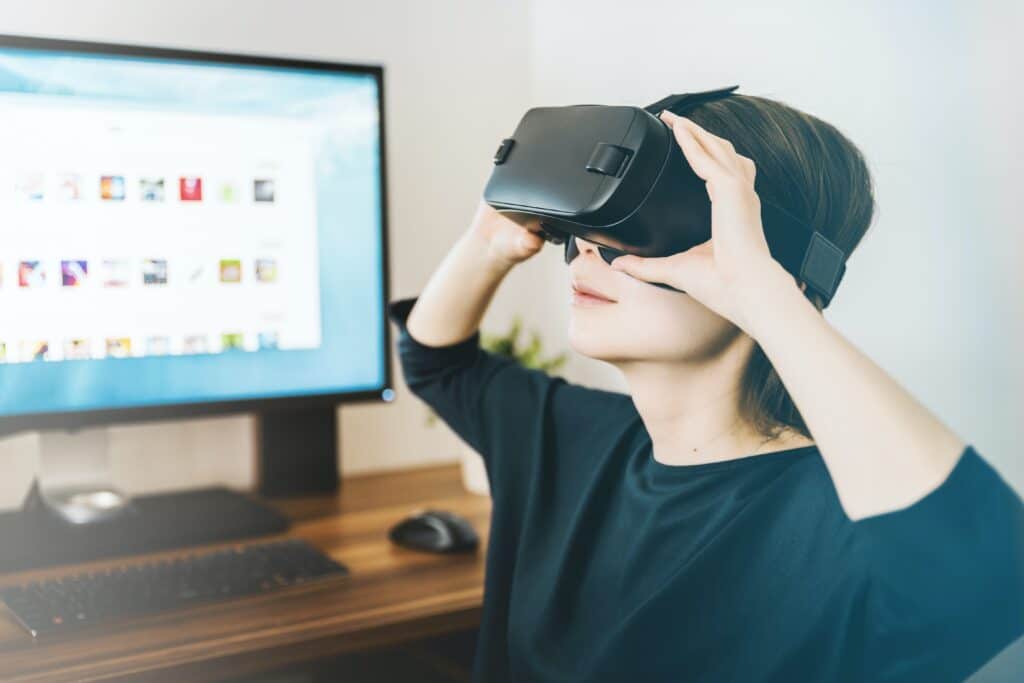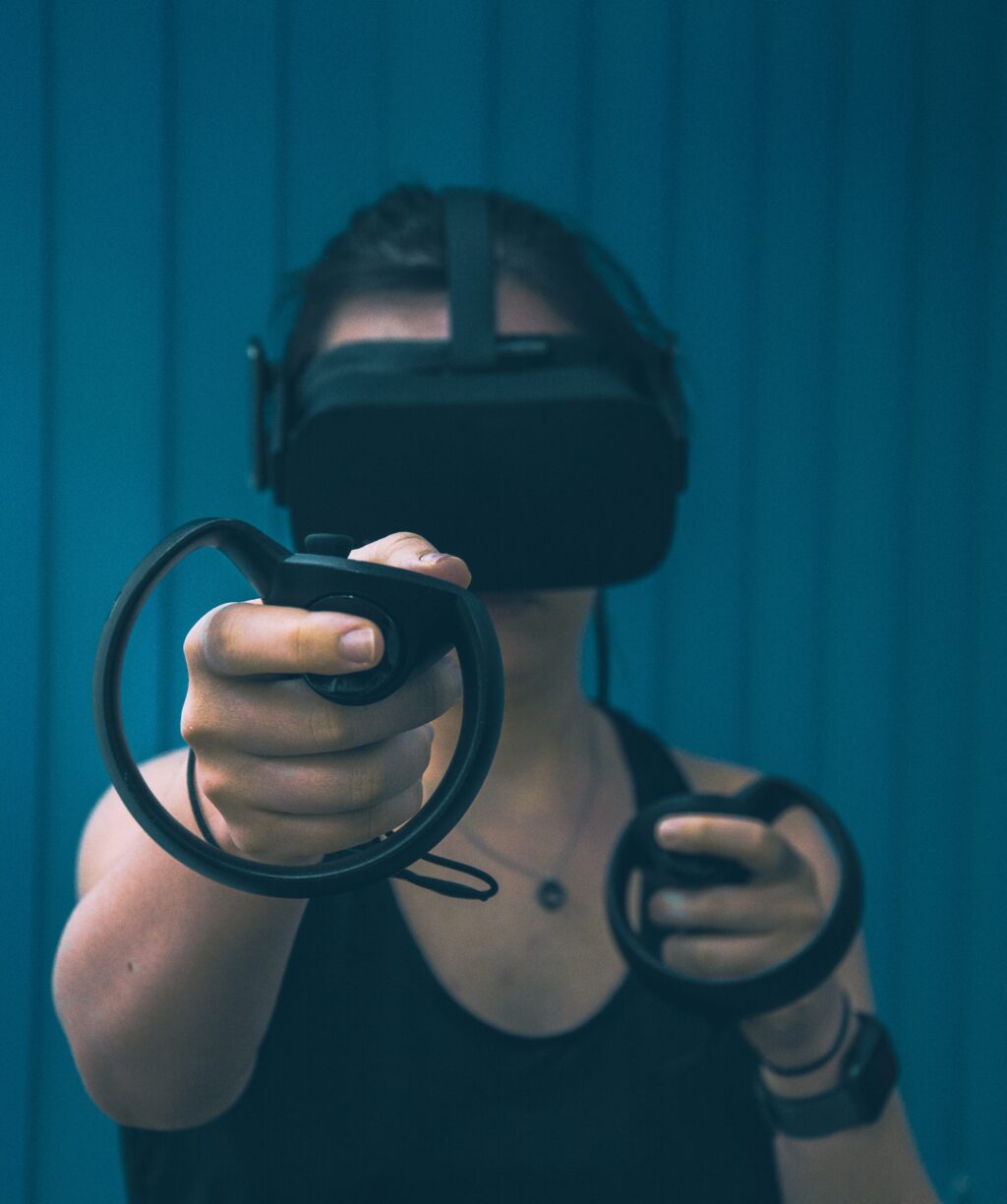Virtual Reality (VR) has revolutionized the way we learn and train. By immersing learners in an interactive, 3D environment, VR allows us to create a realistic learning experience that engages students on a deeper level.
The potential of VR for education and training is boundless, with a wide range of benefits that can drastically improve outcomes. From bridging the gap between theory and practice to overcoming traditional barriers of access, Virtual Reality can revolutionize how we approach education and training.
With its ability to take learners on immersive journeys and make them part of the action, VR offers an unprecedented level of engagement that can help drive positive results. In this article, we’ll explore the many advantages that VR has to offer in the field of education and training.
IMAGE: UNSPLASH
Immersive Learning Experiences
It’s no surprise that virtual reality has become the latest craze in education and training. Forget about the tedious lectures of days gone by, now students can explore a far more exciting and immersive world of learning!
No longer do they have to go through hour-long classes, when with VR they can traverse infinite galaxies in the comfort of their own home.
What’s so great about this technology? Well, it provides an unparalleled level of engagement with the material being taught; allowing students to experience first hand what they’re learning. With VR, you can dive deep into a subject matter, something that wasn’t possible before.
Not only that, but there’s also an element of fun added to the equation. Students will be able to make mistakes without any consequences – allowing them to learn at their own pace and really absorb the material provided.
Virtual reality offers up a unique way for educators to engage their learners – one that is both entertaining and stimulating at the same time.
By utilizing this technology within the classroom environment, users can unlock a wealth of knowledge that was otherwise inaccessible – providing them with an invaluable learning experience!
Accessibility For All Learners
The immersive learning experiences enabled by virtual reality bring a new level of engagement to education and training. However, as with any technology, accessibility is critical to ensure that no learner is left behind.
Accessibility for all learners can be achieved through the use of virtual reality in education and training by:
- Increasing access to educational content regardless of physical location or mobility restrictions.
- Allowing people of all ages, sizes, and abilities to access course materials without traditional barriers such as cost or availability of resources.
- Enhancing the experiences of those who may need additional support due to learning differences or disabilities.
- Making it easier for instructors and trainers to customize curriculums to best meet the needs of their students.
Virtual reality allows educators and trainers to develop innovative experiences that not only make learning more engaging but promote inclusion and equity among all learners.
By providing an accessible medium for education and training, virtual reality has the potential to bridge gaps in access to quality learning materials around the world.
Improved Knowledge Retention
One example of how virtual reality is used for educational and training purposes is at the University of Southern California. They are using it in the medical education program to train future doctors on a variety of procedures, from suturing wounds to performing bronchoscopies.
Virtual reality provides an immersive learning environment that allows students to practice techniques in a safe setting without risk of harm to any patient. The use of haptic feedback also gives learners a realistic sense of touch, allowing for more accurate training.
What’s more, VR can be used to create simulated scenarios that challenge students and test their knowledge, including emergency situations. This helps create deeper understanding and improved knowledge retention.
The use of VR technology in educational and training contexts has been proven effective by research conducted at the University of Southern California, with students showing increased retention rates when compared to traditional methods such as textbooks and lectures alone.
While virtual reality may not completely replace traditional teaching methods yet, its potential for enhancing learning experiences is clear—and promises exciting opportunities for educators and learners alike.
Enhanced Engagement
Virtual reality has the power to revolutionize education and training by providing an immersive experience that can engage learners in ways that traditional learning methods cannot. It can help create a more meaningful learning environment, where students are actively involved, rather than passively receiving information.
With VR technology, students can explore the world from their classrooms or homes, allowing them to gain a better understanding of concepts without physical limitations. VR also provides a sense of immediacy and urgency for tasks, enabling learners to experience mistakes firsthand and learn from them quickly.
By putting learners in situations where they must make decisions based on what they’ve learned, it encourages active learning and critical thinking skills. Additionally, because virtual reality is such an engaging experience, it can even help students retain information better than with traditional methods.
By using virtual reality in education and training, educators have the opportunity to provide a unique and immersive learning experience that goes beyond what is possible with traditional methods.
It enables them to create an interactive environment with endless possibilities for exploration and discovery that will captivate learners of all ages.
With this powerful tool at their disposal, educators have the ability to enhance engagement while helping students develop valuable skills like problem-solving and critical thinking.
Increased Motivation
The enhanced engagement provided by virtual reality can also result in increased motivation for students and trainees. Immersive learning scenarios are designed to motivate users by providing a safe space to make mistakes, learn from them, and become more self-reliant.
As users gain confidence in their abilities, they become more motivated to continue learning and growing. Students and trainees can experience an exhilarating sense of accomplishment when they complete tasks or missions in the virtual world that are relevant to their real-world goals.
The virtual environment provides an ideal platform for problem-solving activities that enable learners to develop critical thinking skills while being rewarded with a sense of achievement.
By engaging users in immersive learning experiences that have real-world implications, virtual reality can be an effective tool for encouraging individuals to strive for excellence.
Learning becomes meaningful as students and trainees realize they are developing competencies that will benefit them both inside and outside the classroom or training center. With this realization comes intrinsic motivation, which is key to long-term success.
Hands-On Practice And Experiential Learning
It’s no coincidence that virtual reality is becoming increasingly popular for education and training. It makes perfect sense; VR allows hands-on practice and experiential learning in a safe, simulated environment. With its interactive capabilities, it can create a real-world experience without the risks of physical danger or cost.
Hands-on practice and experiential learning can be invaluable in educational and training scenarios because it helps to cement concepts in the student’s mind better than any textbook ever could.
Using VR technology, students can interact with a 3D model of a complex system, helping them to gain an intuitive understanding of how it works.
For example, if someone is studying engineering, they can use VR to manipulate parts of an engine and gain a deeper understanding of its components without ever having to touch the real thing.
The ability to learn from within a 3D environment also opens up some exciting possibilities for more creative subjects like design or architecture.
By using virtual simulations, students can get a better feel for scale, size, color and texture before committing to their final project.
In addition to this, they have the freedom to make mistakes without fear of going over budget or wasting materials – allowing them to experiment with different ideas until they find something that works best for them.
In short, virtual reality offers an immersive way for people to learn new skills while eliminating potential safety hazards or financial costs associated with traditional methods of training.
It provides students with an engaging platform where they can explore concepts at their own pace while still feeling connected to their real-world counterparts.
We compared Valve Index vs Oculus Quest 2, check it out.
VR is quickly becoming the go-to resource for educational institutions around the world looking to incorporate hands-on practice into their programs:
- Experiential learning that reinforces knowledge retention.
- An intuitive way to interact with complex systems.
- A cost effective solution that eliminates potential safety risks.
Virtual reality is revolutionizing the way we learn by giving us access to lifelike simulations from the comfort of our own homes – allowing us to gain invaluable knowledge without leaving our seats.
Conclusion
Virtual reality (VR) is a powerful tool for providing immersive learning experiences that can benefit all learners. Apart from learning resources, In the current scenario, Woojer Vest is introduced in the VR gaming world.
It has some sort of sensor on it and delivers the real experience of gaming.
In fact, VR has been shown to improve knowledge retention by up to 25%, and increase engagement and motivation by up to 50%.
With VR, students can engage in hands-on practice and experiential learning to gain a deeper understanding of difficult concepts.
As such, it’s no surprise that the use of virtual reality for education and training is growing rapidly – a recent survey found that nearly 80% of educators believe virtual reality will be an important part of their classroom in the next two years.
As technology continues to evolve, the potential applications for VR in education are limitless.
By utilizing this powerful tool, educators can create engaging and innovative learning environments that promote student success.
I’m excited to see how virtual reality will continue to shape the future of education and training.
IMAGE: UNSPLASH
If you are interested in even more technology-related articles and information from us here at Bit Rebels, then we have a lot to choose from.


COMMENTS